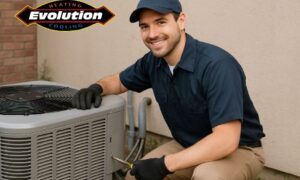Introduction
Cooling towers are devices or structures built to remove extra heat from industrial processes by cooling water. They are primarily used in large buildings, power plants, refineries, chemical processing facilities, and in factories. These towers leverage the principle of evaporation to cool heated water, efficiently transferring heat away from machinery and equipment.
A cooling tower comprises two main elements: the tower design and the mechanical. The tower structure, made from concrete, wood, or fiberglass, provides the framework for the cooling process.
Cooling tower parts include tower fans, gears, driveshafts, cooling tower motors, drift eliminators, hot water basins, and many. In this comprehensive article, we will talk about the most critical components of cooling towers and how they work, how to maintain good thermal efficiency, their maintenance, and their benefits in different industries.
Main Component of Cooling Towers
Multiple cooling tower components work together to run cooling towers and water distribution system effectively and efficiently without any hurdle. They can be divided further into main components, such as mechanical, electrical, and controller tower components. Here, we are going to discuss the essential tower components, including cooling tower nozzles, cold water basins, cooling tower valves, drift eliminating fans, fan decks, fan cylinders, and more.
Cold Water Basin
The cold water cooling tower basin floor, also known as the “Sump Basin,” is a vital component of the working of most cooling towers. The cooling tower basin serves two main functions: a cooled water collector and a Storage and distribution basin.
- Collection of Cooled Water: After passing through the cooling tower, water is reached and gathered in the cold water basin when it is cooled. The cooled water is again redistributed back to the condensers, the central cooling tower system for circulation to absorb extra heat, and this process is carried on continuously.
- Storage and Distribution of Cooled Water: The second function of the cooling tower is to act as a storage area for the cooled water and, when needed, ensure the continuous supply of water to carry on the other vital cooling tower operations. The cold water basin is generally located below the ground level.
Cooling Tower Fill Media
The other cooling tower fill media names are “Fill Pack” and “Filling,” an essential component used to increase the heat transfer process by different methods.
First, they enhance the contact area between the surrounding air (in the cooling tower) and incoming hot water ( from the cooling tower) for efficient heat transfer from warm water to the air, ultimately cold the water inside the cooling tower structure.
Fill media also helps in the water distribution to ensure quick and uniform cooling and also serves as a water retainer to keep the water inside for longer to maximize the heat transfer process. They are made from different materials like Polyvinyl Chloride (PVC), Polypropylene (PPE), and others, but the most used and preferable is PVC due to its durability.
There are two main types of fill media: Splash fill and Film fill. Splash film apart the water (splash-style) into tiny droplets that increase the surface area of water distribution, while Film fill gives a thin and even layer of water for effective heat transfer.
Cooling Tower Fan Motor
The cooling tower fan motor is necessary and one of the replacement cooling tower parts for the smooth operation of a cooling tower. It successfully drives the cooling tower fans to draw in airflow and create the required airflow through the tower to maximize the cooling process of cooling towers. The cooling tower’s fan’s primary function is to provide enough power to rotate the fan blades to push the air through the tower, so it should be very powerful for continuous and efficient performance.
Cooling tower motors mainly came in two types: ( Fan cylinder & Fan Deck)
- Belt Drive Fan Motors: They have pulleys and belts to transfer the energy to the fans. One main advantage is that they offer extra flexibility to adjust the fan speed but require extra maintenance.
- Direct Drive Fan Motors: These tower motors are directly connected to the fans without additional belts; they are preferred for their reliability and low maintenance.
As cooling tower motors is often exposed to harmful or harsh environments, they are typically designed with solid and durable materials such as Aluminum and glass fiber-reinforced plastic to withstand exposure to harsh elements.
Cooling Tower Drift Eliminator
Cooling tower drift eliminators serve a critical function in cooling towers, and they are manufactured using PVC. They minimize the loss of water droplets and avoid the amount of water released into the environment in the cooling tower, projecting the airflow in multiple directions. The primary function of these rift eliminators is to catch and reserve the water droplets and cooling flow that come into the air stream.
There are various types of drift eliminators, like wave-form, grid-form, Sinusoidal Drift, and Cellular Drift, and many have advantages and drawbacks. They should be chosen according to the cooling tower’s basic needs and place of installment (environment)
In simple words, we can say that in cooling tower drift eliminators, the water is extracted from the air by altering its direction through the drift eliminator.
Distribution Float Valves
The cooling tower float valve regulates the hot water flow and distributes it across the cooling tower. These brass float valves are made up of corrosion-resistant materials because they continuously have to make contact with water.
Float valves regulate the liquid or water flows into a tank and avoid overflow by automatically shutting off the flow when the liquid gets to the desired level and hot water measurement is done.
Cooling Tower Gearboxes
Cooling tower gear boxes or gear reducers are used to decrease the motor’s high-speed rotation to get the speed required for the cooling tower fan’s optimal function. Gearboxes are usually designed to deal with low-speed and high-torque, which are perfect for huge fans of cooling towers.
They are available at different reduction rates and designs, depending on the type of tower system. Gearboxes are energy efficient, noise reducer, and durable; they can tolerate different environments like humid or warm.
Cooling Tower Nozzles
Cooling tower Nozzles are one of the most crucial tower components that increase the surface area for heat transfer and play an essential role in the cooling process of towers. Their main function is to distribute the warm water smoothly and evenly on the fill media. They are mostly installed in the crossflow cooling towers to ensure the breakdown of the water into small water droplets and maximize the surface area for heat transfer by evaporation.
With uniform water distribution, they are also efficient in reducing water wastage, increasing fill media lifespan, and enhancing cooling towers’ cooling efficiency. Nozzles are available in various types like spray nozzle, spiral, fan, rotatory, orifice, and more.
Level Sensors and Alarms
Cooling tower alarm and level sensors are critical to check and maintain the water level inside the cooling tower for primal operation in the pump suction line. There are many types of level sensors available to keep an eye on the water level, such as:
- Radar Level Sensors: It is one of the high oil level switches that provide accurate, highly precise, and non-contact measurements by using radar technology.
- Float Switches: A mechanical device that uses the floating system to detect; for example, when water reaches the desired height or limit, the float moves and triggers the signal to the switch to control water flow in tower tech.
- Vibration Switches: It is very important in the cooling tower to check the vibration level of cooling tower equipment.
Air Intake Louvers (Air Inlet Louvers)
Cooling tower louvers handle the amount and direction of airflow penetrating the cooling tower components and prevent the sunlight rays from entering the cooling tower to avoid algae production and minimize the chances of biological contamination that can affect the water quality. Air intake louvers also block debris, such as dust, from entering the cooling tower, keeping the system clean. If counterflow air intake louvers are not properly cleaned and maintained, scaling has been found to form on them. This problem reduces the system’s overall efficacy by limiting air circulation. Cooling tower louvers prevent water from splashing out of the reservoir.
Maintenance and Upkeep of Cooling Tower Components
Maintaining the cooling tower structure and mechanical system is necessary for their efficient operation and longevity. Here is the step-by-step checklist to help keep your cooling tower in optimal condition.
- Annually thorough inspections are vital to identify potential issues before they become major problems.
- In order to prevent scaling, corrosion, and biological growth, adjust chemical levels inside the cooling tower.
- Clean filters drift eliminators, and fill material regularly to ensure optimal airflow and water flow.
- Regularly check damaged components, such as fans, motors, and gearboxes, and replace them.
- Apply cathodic protection to prevent corrosion and extend the lifespan of structural parts.
- Document maintenance activities, water test results, and repairs to track performance and identify areas for improvement
Benefits of Cooling Tower
Being a significant component of major industries, the cooling tower has various advantages. Let’s have a closer look at the benefits listed below:
Energy Efficiency:
Cooling towers help reduce energy consumption in three ways. They decrease power requirements, lowering energy bills by reducing the amount of energy needed to operate cooling systems. Additionally, they minimize energy losses by efficiently transferring heat from systems to the atmosphere and preventing energy waste. Furthermore, they enhance overall system performance by optimizing cooling processes, ensuring systems run smoothly, reducing strain, and lowering energy consumption.
Water conservation:
Cooling towers significantly reduce water consumption through water circulation, reduce blowdown rates, and eliminate effective drift. Advanced designs, such as counterflow and crossflow configurations, further minimize water loss through water distribution piping.
Low maintenance:
These are designed for low maintenance and feature easy accessibility, simple design, and corrosion-resistant materials. Automated controls also simplify operations. This reduces downtime, maintenance costs, and the risk of leaks and water damage.
Environmental sustainability:
Such towers promote environmental sustainability by reducing carbon footprint through energy-efficient designs. They improve air quality by removing heat and pollutants, contributing to a healthier ecosystem. This reduces greenhouse gas emissions and supports eco-friendly operations.
Temperature control:
These towers provide precise temperature regulation, consistent process cooling, and efficient heat removal. This ensures reliable temperature maintenance, optimizing industrial processes, and improving product quality. All this helps extend the equipment’s lifespan and enhance system reliability by frigid coil cooling towers.
Application of Cooling Tower
- Cooling towers are integrated with HVAC systems for commercial and residential buildings to provide efficient cooling and reduce energy usage.
- In industrial settings, they cool machinery and equipment, preventing overheating and damage. This maintains optimal operating conditions.
- In power plants, steam is condensed by these towers, enabling efficient energy production. They dissipate heat, maintaining turbine performance.
- For data centers, cooling towers manage the heat generated by servers, preventing overheating. This ensures reliable operation.
- When used in oil refineries and chemical plants, cooling towers provide essential process cooling. They regulate temperatures to maintain ideal operating conditions.
Conclusion
In this article, we have discussed the most important cooling tower parts and functions that every tower owner needs to know for maximum efficiency and a smooth process. It also highlighted their critical roles in maintaining efficient thermal management.
Components of cooling towers need proper maintenance as they can reduce their efficiency with time. We also discussed how to maintain and keep an eye on the components of a cooling tower for maximum output and efficiency. By understanding the design, functionality, and maintenance, industry professionals can optimize cooling tower performance, reduce energy consumption, and extend equipment lifespan.





































